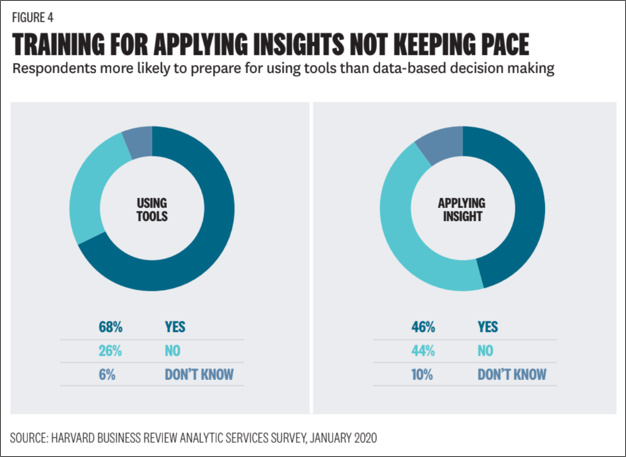The Business Intelligence market has existed for thirty years now. Every business leader says they want to be a data-driven business, and yet, only a third confidently claim they are.
After thirty years, I could be a pessimist and call this a failure. Or I could play the optimist and say we are making slow, painstaking progress.

As brutal as the COVID19 crisis is from both a health and economic perspective, it is proving to be a forcing function that will show how data and analytics will finally have its breakout moment.
Central to my belief on this industry’s breakout moment is the degree that frontline workers are empowered with easy access to data at the point of impact. It is also dependent on the degree that leaders get a grip on all the blockers to unlocking the value of data, particularly culture.
That’s why the findings of the “The New Decision Makers” report, a Harvard Business Review Analytic Services study, created in participation with ThoughtSpot, are so important for business leaders and employees who truly want to transform.
The report showed a direct and real connection between empowering those at the frontlines and business performance:
87% of survey respondents in this latest HBR report say empowering frontline workers will make their organizations more successful.
69% of respondents have increased customer satisfaction
67% of respondents have improved product and service quality
These are tremendous, quantifiable benefits. And yet, some organizations don’t believe in the value or possibility of empowering frontline workers with data. No wonder HBR labels this group, the “laggards.”
To be fair, perhaps these laggard organizations believe the cultural and technical challenges are too much to overcome. 67% of organizations surveyed by Deloitte say they can’t access data or are not comfortable.
Although it has taken us awhile to get here, I think the moment for data and business analytics software empowering frontline workers has finally arrived:
Thirteen years ago, I wrote an article with Microsoft’s rallying cry of BI for everyone. Microsoft envisioned a ten-fold increase in the number of BI users that still has not materialized.
Five years ago, we saw how visual based data discovery helped the data analysts do more, faster. It’s one contribution to the analytics and BI adoption rate moving from 22% to 35% (according to the 2019 Gartner MQ customer reference survey).
Today, search and AI are empowering non analysts to access data where and when they want, whether via a mobile app or embedded. Better data scalability and the agility of cloud allows for more granular insights that are particularly important to front line workers.
In the last year, I’ve journeyed the world to talk to customers about what’s working and what’s failing as it relates to creating a data-driven organization, especially for those on the frontlines. The top three things people have repeatedly shared with me that the HBR report further confirms are culture, data fluency, and the talent gap.
Disrupt the Culture
Culture is such a slow-moving yet essential component to empowering the frontlines. Gut-feel and experienced-based decision making is as comfortable as a warm blanket on a chilly day. Why change?
Status quo is so much easier and safer than confronting the reality that, in our digital world, data is the only way to really know our customers. We are only five months into 2020 and yet the number of new CEOs, CIOs, and CDOs at leading companies should be eye opening. To change the culture, organizations may have to change the leadership to bring in a disruptor, a change agent. In challenging economic times, people are rightfully afraid of loss of jobs. Data and analytics professionals who have built their careers around a certain way of working with data or certain technologies may be most vested in preserving the status quo. And yet, the harsh economy, which is likely to only get harsher, should be the greatest motivator for everyone to work smarter, faster, with maximum efficiency.
As Jeff Noto, SVP of Business Analytics at Verizon said in a recent webinar, “For leaders in the analytics industry, this is a time for maximum impact. The extent we can be nimble, we can be positioned to accelerate the adoption of data -driven analytics.” The same is true for the data and analytics experts who know how to unlock the value of data but who may have felt unheard, underfunded, or sidelined by power and politics and conflicting priorities in the past. Now is your moment. I encourage you to lead the charge to bring data and analytics to bear in a really difficult economic environment. Be brutally honest with your leaders and stakeholders about what it will take to get there.
Drive Data Fluency
We are in the middle of a global pandemic with the world largely failing to understand the data gaps we have. Data people get it, frustratingly so, but non data experts incorrectly think 1 million lab-confirmed cases means there are only 1 million cases in the USA rather than an estimated 5 million total cases at the end of April. We can’t even attempt to get to a global count, as we see data quality and distrust country by country. If even smart citizens and policy makers barely understand these data gaps, is it hopeless to think corporate data would be any easier to understand?
I am disheartened to see that the data and analytics industry continues to spend way too much time training people on the tools and technology (68%) and not enough on applying the insights (only 46%).

There are some bright spots: kudos to Payback - a European customer loyalty program - that rightfully flips their training efforts to 20% on tools and 80% on using the data.
As the CDO of VMWare Stephen Harris described in The Data Chief Podcast: “I started to realize that my data literacy was at ninety percent, whereas the other individual's data literacy and the practices around understanding data, how it transforms through systems and then shows up for the consumer to use it, were on two different ends of the spectrum. And so my job was as much to educate, to inform, and to bring them along the journey, as was it to learn and to listen more than I speak. And I always have to throttle that in order to be effective." With 63% of organizations now having a CDO, according to Bain, I hope CDOs will make data fluency a part of their charter. This is one more responsibility for a data and analytics leader, regardless of the title held, in an already tough role.
Reimagine the Talent Gap
The industry often talks about a talent gap in data and analytics. We have so many unfilled jobs in this space, and when we count the surge in open AI jobs, the lack of talent is getting worse. The pandemic is expected to increase the demand for data engineers and AI specialists globally according to IDC. But the COO of CNA Insurance, Michael Costonis recently pushed back on me, saying, “We don’t have a talent gap. We have an imagination gap.”
The more I think about this discussion, I agree, especially as it relates to leveraging data for frontline workers.
People are so accustomed to dashboards and the order-taking, lengthy modeling process to create one that search and AI generally scares the hell out of them. I hear the counter arguments:
It will kill our jobs!
Users will get wrong results!
Or from this LinkedIn post, from Ahmed Yusuf, a long-time BI manager, “It might reduce BI project development cycle by at least 40%. In sum, it looks like ThoughtSpot is intimidating BI industries.”
Some may not even yet realize there is a better, more modern and agile alternative. Just imagine what we could if we brought data to those on the frontlines:
A waiter recommending an alternative dessert when that popular chocolate cake is sold out.
A financial advisor proactively offering a minimum payment plan even before you called the call center, because they saw your direct deposit paycheck suddenly stopped.
An alert that tells a manager his top female employees will churn because they are consistently interrupted in Zoom meetings.
A nurse that sees that certain types of care provided to COVID19 patients yield better outcomes than the current standard of care in their own hospital.
All these high value use cases are technically possible today. Yet, few imagine these use cases. The frontline workers don’t ask. They don’t know it’s possible. Empowering frontline workers requires greater collaboration and indeed imagination on everyone’s part, from leaders to data and analytics professionals to those on the frontlines themselves.
As I wrote in both editions of the Successful Business Intelligence Books in 2008 and 2013:
"To be successful with business intelligence, you need to be thinking about deploying BI to 100% of your employees as well as beyond organizational boundaries to customers and suppliers. "
My vision seems so small compared to ThoughtSpot’s mission of a fact-driven world. I was merely aspiring for each organization. Imagine what we could do if we extend that to the world!








